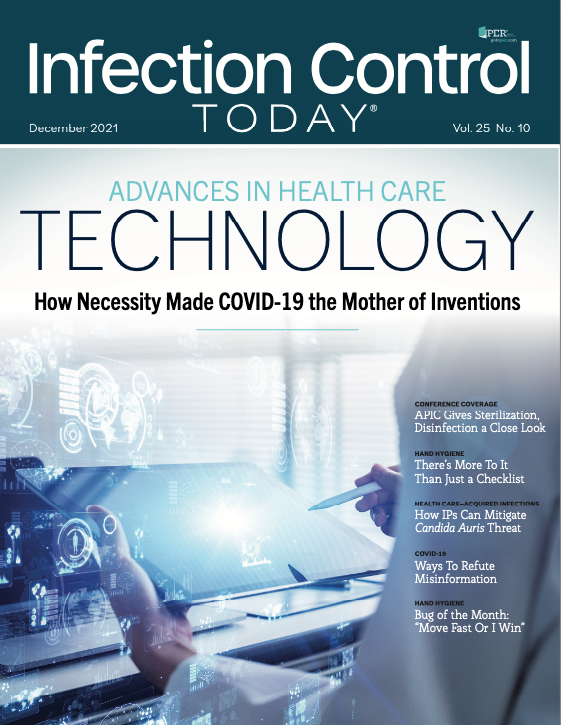Air Sampling Detects COVID-19 Spread in Dormitories
Compared to cases confirmed by human clinical testing, the air sampling used in the college dorms in the study had a success rate of 75%–100% in detecting infection by SARS-CoV-2.
Holidays set the table for the gathering of family and friends indoors. However, that could lead to trouble, as the Centers for Disease Control and Prevention (CDC) has pointed out during much of the COVID-19 pandemic.1 The horrific surge resulting from last year’s holidays taxed the US health care system and forced infection preventionists (IPs) and other health care professionals to work to the point of exhaustion.2,3
COVID-19 also exposed some serious systemic problems in the country’s health care system, most notably with nursing homes and other long-term care facilities (LTCFs).4 But COVID-19 also underscored the need for proper ventilation in buildings, not just hospitals and LTCFs but office buildings and especially schools.
A preprint study in the American Journal of Infection Control (AJIC) shows how easily COVID-19 can spread via ventilation units in college dormitories. Proper ventilation in schools is crucial.5 As Kevin Kavanagh, MD, a member of Infection Control Today®’s (ICT®’s) Editorial Advisory Board (EAB), told us in July6: “We need to change our infrastructure for schools with ventilation systems, increasing complete air exchanges.”
In the AJIC study, investigators with East Carolina University sampled the air in 2 multifloor dorms in search of SARS-CoV-2, detecting COVID-19 in multiple places and concluded that air sampling could be an effective way to monitor the safety of buildings.
The air samples were collected in the spring semester from January 19 to April 29, 2021, using the quantitative reverse transcription polymerase chain reaction (RT-qPCR) method. The 2 dorm buildings used in the study contain 225 rooms that include student dorms, offices, staff apartments, bathrooms, and storage space.
“We conducted the current study as a cleaner, easier, and safer alternative method to the wastewater track tracing method, and we have shown it is possible to detect viruses in HVAC air samples collected at 1 location from the dorm’s return air,” the study states. “It is possible that performing air sampling for SARS-CoV2 on each floor of a large building may yield greater sensitivity.”
In 2 large dorm rooms, investigators detected COVID-19 in 11 samples. “When compared with student nasal swab RT-qPCR testing, we detected SARS-CoV-2 in air samples when a PCR-positive COVID19 student was living on the same floor of the sampling location with a detection rate of 75%,” the study states.
Investigators argue that their study, which, to their knowledge, is the first to detect COVID-19 using PCR detection on air samples from HVAC systems, underscores the crucial role air monitoring can play in detecting pathogens in large buildings and “especially congregant living settings.” When it comes to stopping contamination, early intervention matters.
Source: Centers for Disease Control and Prevention

“Future building designs should include HVAC access for such sampling, and public health policies should consider implementation of HVAC surveillance testing either routinely or during times of contagion,” the study states. “Our data suggest air sampling at each floor would be beneficial and that more distant sampling is less sensitive.” Just how much their advice will be followed remains to be seen.
References:
- Diamond F. Infection preventionists gird for Thanksgiving fallout. Infection Control Today®. November 23, 2020. Accessed October 28, 2021. https://www.infectioncontroltoday.com/view/infection-preventionists-gird-for-thanksgiving-fallout
- Diamond F. Fast and furious: COVID surges to unprecedented levels in U.S. Infection Control Today®. December 3, 2020. Accessed October 28, 2021. https://www.infectioncontroltoday.com/view/fast-and-furious-covid-surges-to-unprecedented-levels-in-u-s-
- Ward-Fore S. The year infection preventionists showed the world their worth. Infection Control Today®. November 11, 2020. Accessed October 27, 2021. https://www.infectioncontroltoday.com/view/the-year-infection-preventionists-showed-the-world-their-worth
- Diamond F. Who will get nursing homes off life support? Infection Control Today®. September 16, 2021. Accessed October 28, 2021. https://www.infectioncontroltoday.com/view/who-will-get-nursing-homes-off-life-support-
- Sousan S, Fan M, Outlaw K, Williams S, Roper RL. SARS-CoV-2 detection in air samples from inside heating, ventilation, and air conditioning (HVAC) systems- COVID surveillance in student dorms. Am J Infect Control. 2021:S0196-6553(21)00674-X. doi:10.1016/j.ajic.2021.10.009
- Diamond F. Everybody needs to be vaccinated and wear a mask. Infection Control Today®. July 27, 2021. Accessed October 28, 2021. https://www.infectioncontroltoday.com/view/everybody-needs-to-be-vaccinated-and-wear-a-mask

Endoscopes and Lumened Instruments: New Studies Highlight Persistent Contamination Risks
May 7th 2025Two new studies reveal troubling contamination in both new endoscopes and cleaned lumened surgical instruments, challenging the reliability of current reprocessing practices and manufacturer guidelines.
Happy Hand Hygiene Day! Rethinking Glove Use for Safer, Cleaner, and More Ethical Health Care
May 5th 2025Despite their protective role, gloves are often misused in health care settings—undermining hand hygiene, risking patient safety, and worsening environmental impact. Alexandra Peters, PhD, points out that this misuse deserves urgent attention, especially today, World Hand Hygiene Day.